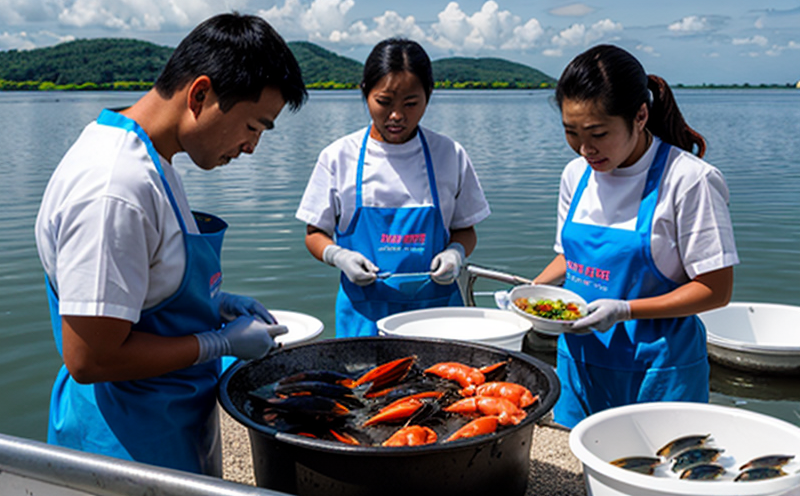ISO 21528 Enterobacteriaceae Testing in Aquaculture Products
The ISO 21528 standard provides a comprehensive framework for detecting and quantifying Enterobacteriaceae, a family of Gram-negative bacteria that includes both beneficial and potentially pathogenic species. In the context of aquaculture products, this testing is critical for ensuring food safety and compliance with international standards.
Enterobacteriaceae are naturally present in many aquatic environments, including fish and shellfish. However, their presence can also indicate contamination from fecal matter or other sources that may pose risks to human health. The ISO 21528 standard outlines a method for detecting total viable counts of Enterobacteriaceae as well as the specific detection of coliforms within food products.
The testing process involves several steps, starting with the collection and preparation of samples from various points in the production chain. This can include raw materials, finished products, and environmental swabs. Once collected, these samples are inoculated onto selective media that allows for the growth of Enterobacteriaceae while suppressing other microbial species.
The incubation period is crucial as it ensures that all viable bacteria have sufficient time to grow on the medium. After incubation, colonies are counted and identified using biochemical tests such as lactose fermentation or IMViC (Indole-Methyl Red-Voges-Proskauer) reactions. These tests help differentiate between various species of Enterobacteriaceae.
The results from this testing are used to assess the quality and safety of aquaculture products, helping manufacturers make informed decisions about product recalls, process improvements, or further processing steps like cooking or pasteurization. Compliance with ISO 21528 ensures that these products meet international standards for food safety.
For quality managers and compliance officers in the seafood sector, understanding the nuances of this standard is essential. It allows them to identify potential risks early on, ensuring that their operations remain compliant with regulatory requirements. R&D engineers can leverage ISO 21528 data to optimize production processes or develop new products.
From a broader perspective, consumers benefit from safer seafood products. By implementing ISO 21528 testing, aquaculture producers contribute to public health by minimizing the risk of foodborne illnesses associated with Enterobacteriaceae contamination.
Why It Matters
The importance of ISO 21528 in the context of aquaculture cannot be overstated. Contamination from Enterobacteriaceae can lead to serious health issues, including gastrointestinal infections and antibiotic resistance. Therefore, ensuring that these bacteria are detected at low levels is crucial for maintaining product safety.
Compliance with international standards such as ISO 21528 not only enhances the reputation of aquaculture companies but also ensures they meet regulatory requirements set by governments worldwide. This can help prevent recalls and legal issues, saving both time and money in the long run.
For R&D engineers, this standard offers valuable insights into microbial behavior during different stages of production. They can use these data points to refine their processes or explore novel methods for detecting contamination early in the supply chain.
The presence of Enterobacteriaceae also serves as an indicator of hygiene practices within aquaculture facilities. Regular monitoring through ISO 21528 testing allows for continuous improvement of sanitation protocols, which ultimately leads to better quality products and increased consumer trust.
Scope and Methodology
The scope of the ISO 21528 standard encompasses the detection and quantification of total viable counts of Enterobacteriaceae in aquatic products. This includes both wild-caught seafood as well as farmed species such as salmon, shrimp, and tilapia.
Methodologically speaking, the first step involves selecting appropriate sampling sites within the production process where contamination could occur. These might include fish pens, processing plants, or storage facilities. Samples are then taken using sterile techniques to avoid introducing contaminants into the sample.
Upon arrival at the laboratory, samples undergo preliminary examination to ensure they meet acceptance criteria specified in ISO 21528. This includes checking for signs of spoilage or other abnormalities that could affect results.
The actual detection process uses selective media designed specifically for Enterobacteriaceae growth. After incubation and colony counting, further identification is performed using biochemical tests like IMViC reactions and enzyme assays specific to particular genera within the family.
Accuracy of these methods is paramount; therefore, proficiency in microbiological techniques forms part of training programs provided by reputable laboratories offering ISO 21528 services. Regular calibration of equipment used during testing ensures consistent results over time.
Benefits
Implementing ISO 21528 enterobacteriaceae testing in aquaculture offers numerous benefits beyond mere compliance with international standards:
- Enhanced Safety: Detecting and controlling Enterobacteriaceae helps protect consumers from foodborne illnesses.
- Better Hygiene Practices: Routine monitoring encourages better hygiene practices throughout the supply chain, reducing contamination risks.
- Improved Quality Control: By identifying problem areas early in production, companies can improve overall product quality.
- Informed Decision-Making: Data generated through ISO 21528 testing supports evidence-based decision-making regarding process improvements or recalls.
- Increased Consumer Trust: Demonstrating commitment to food safety increases consumer confidence in the brand and its products.
- Competitive Advantage: Meeting international standards can set a company apart from competitors, potentially leading to increased market share.
- Reduced Legal Risks: Avoiding contamination issues reduces the risk of costly lawsuits or regulatory penalties.
- Sustainable Production: By maintaining high hygiene standards, companies contribute positively towards sustainability goals associated with aquaculture.
The combination of these benefits makes ISO 21528 enterobacteriaceae testing an indispensable tool for ensuring the safety and quality of seafood products.





